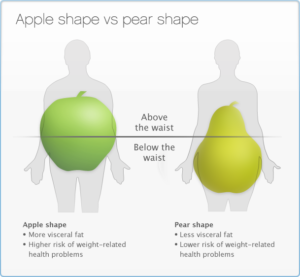By: Sarah Muniz, RD, LDN Avance Care Registered Dietitian
Healthy Weight Week is celebrated in January as a time to turn our focus to total health and understanding that health cannot be measured by a number on the scale. Health is very individualized and comes in all shapes, sizes, and ages. During Healthy Weight Week, we encourage you to commit to a life free of “dieting” and to pursue lifestyles that are livable and sustainable, through eating well, having an active lifestyle and feeling comfortable and happy in your body.1
Here are some points to consider when determining your own healthy weight range. And, remember! It’s just that, a range. There is no perfect number.
Waist Circumference: Having a larger waist circumference and carrying most of your weight in this region increases your risk for developing heart disease and Type 2 Diabetes.
• Females: risk increases when waist circumference is 35 inches or greater
• Males: risk increases when waist circumference in 40 inches or greater
BMI: Measuring your Body Mass Index (BMI) can help to give you an idea of your weight classification (i.e. average, overweight, or obese) and potential health risks associated, but it should not be used as a standalone measure to gauge your health. BMI compares your height with your weight, but it does not take into account how much of your weight is muscle or fat.2 BMI results can often be inaccurate for athletes as they have higher muscle masses and may be classified as overweight. Also, BMI results for the elderly may be inaccurate, as their BMI may appear normal even though muscle mass has been lost due to aging.
Waist-to-Hip Ratio: To calculate this, divide waist circumferences by hip circumference.
• Females: disease risk increases with ratio greater than or equal to 0.85.4
Ex: 28 inches (waist)/37 inches (hips) = 0.75 (not at high risk)
Ex: 36 inches (waist)/40 inches (hips) = 0.9 (at higher risk)
• Males: disease risk increases with ratio greater than or equal to 0.9.4
Ex: 32 inches (waist)/36 inches (hips) = 0.88 (not at high risk)
Ex: 40 inches (waist)/36 inches (hips) = 1.11 (at higher risk)
Body Shape: Where you carry more of your fat mass is important and can be a risk factor for heart disease and Type 2 Diabetes.2
• Apple Shaped: You carry more fat in your abdomen (more visceral fat = more fat around your organs). This puts you at a higher risk for weight-related health problems.
• Pear Shaped: You carry more fat below the waist in your hips and thighs (less visceral fat = less fat around your organs). This puts you at a lower risk for weight-related health problems.

Body Composition: This style of testing measures fat-free (lean) mass vs. fat mass in your body. Various ways to measure body composition include skin folds testing, bioelectrical impedance
What Healthy Eating Means and Why it Affects YOUR Healthy Weight…
As we celebrate Healthy Weight Week, it’s also important to celebrate “eating healthy foods” (consuming more healthy foods as the foundation of your diet) and “healthy eating habits” (the confidence, control and positive outlook you have when you choose what to eat). While it is important for you to try and have balanced meals and consume your fruits and vegetables, whole grains and lean proteins, it is also important for you to think positively about your eating habits. Obsessing about calories, carbohydrates, fats or any other nutrient is not healthy eating.3 This can make meal times and meal planning stressful and unpleasant for you. Instead, try to make meal planning and mealtimes fun and enjoyable. Develop theme nights, like Meatless Monday or Taco Tuesday and involve everyone in the meal prepping process. Maintaining a healthy attitude about your body image can also help shape your healthy eating habits. When you harbor harsher attitudes about your body, you are more likely to follow restrictive eating patterns and focus less on balanced, healthy eating.3

So, when it comes to figuring out a healthy weight range for yourself, take into consideration the points listed above and remember to enjoy your food, to focus on total health and to find sustainable lifestyle habits that support your goals.
REFERENCES
1. https://www.fitwoman.com/weight-loss-program-reinvented/weight-loss-support/healthy-weight-week/
2. http://healthyweightweek.com.au/assess-your-body-weight/
3. http://www.eatright.org/resource/health/weight-loss/your-health-and-your-weight/emphasizing-health-vs-weight- for-body-positive-thinking
4. https://www.hsph.harvard.edu/obesity-prevention-source/obesity-definition/abdominal-obesity/
